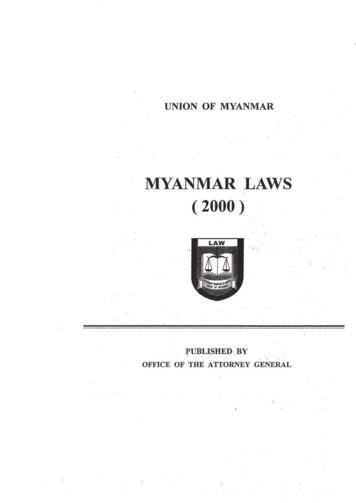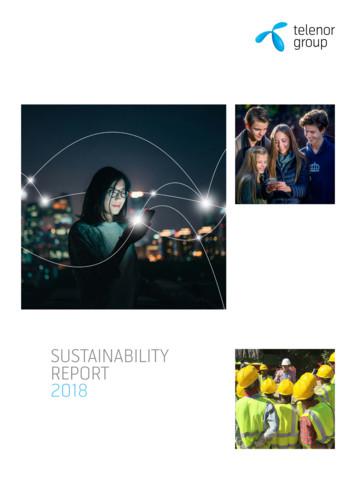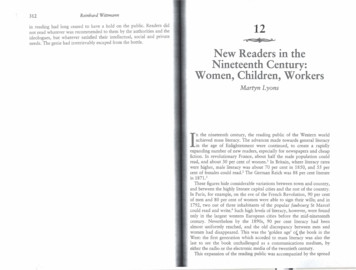REALISING DIGITAL MYANMAR - Telenor
REALISINGDIGITALMYANMARLeapfrogging to aninclusive digital economy
CONTENTSTABLE OF CONTENTSThe Government’s Vision For Digital Myanmar03Telenor’s Shared Vision for Digital Myanmar05Focus Area 1: Digital Frameworks06Focus Area 2: Digital Infrastructure08Focus Area 3: Digital Ecosystem 10Focus Area 4: Digital Skills 13Focus Area 5: Digital Government 15Focus Area 6: Digital Enterprises 17Focus Area 7: Digital consumers 19The Journey to Digital Myanmar0221Summary: Role of government, civil society, regulator and private sector21Proposed Roadmap to 202322ContentsREALISING DIGITAL MYANMAR
THE GOVERNMENT’S VISIONFOR DIGITAL MYANMARFollowing four decades of isolation, economic reforms beginning in 2011 havedriven Myanmar’s reintegration with the international community. This hasset off an extraordinary series of events, including the liberalisation of thetelecom sector and a democratically elected government. This creates newopportunities for the country to leap-frog from one of the least developedeconomies, to a low- to middle-income country equipped for the 21st century.According to the McKinsey Global Institute, the size of Myanmar’s economyis expected to quadruple by 2030.While the government has created the right conditions for thetelecommunication sector to grow to a 105% SIM penetration, 80%smartphone penetration and the among the fastest mobile broadbandin Asia in just 3 years1, Myanmar will need to adopt digital solutions to itsmost pressing challenges2, establishing a Digital Economy in the process.In August 2016, Myanmar’s democratically elected government issued apeople-centred 12-point Economic Policy, which aims to attract sustainableinvestment, increase employment and skills while raising competition.The plans aim to establish a digital government strategy and ane-government system, as well as a data ID card system.Through modernizing its critical agricultural, tourism, manufacturing,financial services and infrastructure sectors, improving tax collection andtrade, upgrading the education system, expanding the reach of the healthsystem to building environmentally sustainable cities, widespread adoptionof digital technologies will provide inclusive and sustainable socio-economicdevelopment across all states and divisions as targeted by the government’s12-point Economic Policy.To facilitate Myanmar’s digital transformation, the government establishedthe Digital Economy Development Committee (DEDC) with Vice PresidentU Henry Van Thio as patron. During the inaugural meeting of the DEEDC,he emphasised the Committee was: “formed with the intention of performingthe tasks of effective and successful implementation of national economicpolicies, provision of governmental supports for the successful emergence ofdigital economy in the country, development of other economic sectors basedon digital economy, development of social affairs, education, health andeconomy by the use of digital technology, creating Myanmar as a digital hubof ASEAN region by upgrading better economic environment anddigital technology. “The Digital Economy Development Committee is in the process of settingup goals to be achieved by 2020.123DIGITAL ECONOMYDEVELOPMENTCOMMITTEE GOALS202015%275%additional GDP growth dueto Digital Economy (direct &spillover effects)employment rate of ICT graduates380%of G2B and 50% of G2Cservices digitized410Mbpsinternet nationwide, ultra-highspeed internet in major cities550%of transactions cashless650%of micro, small and mediumenterprises (MSMEs)using technology72xlocal digital startups83xincrease in digitalforeign investment9Top 100rankings on global indexes3ITU, Ministry of Transport and CommunicationsMcKinsey Global Institute, 2013E-Government Development, Network Readiness, Ease of Doing Business, Global Innovation Index03The Government’s Vision for Digital MyanmarREALISING DIGITAL MYANMAR
THE GOVERNMENT’S VISIONFOR DIGITAL MYANMARHOW IS MYANMAR DOING4?Myanmar’s Digital Economy has high potential if appropriatedigital policies are developed and implemented. Due tomany years of low economic development, the country trailsits regional peers in a variety of digital rankings, rangingfrom the World Bank’s ease of doing business, the UN’se-government index, networked readiness index, the ICTdevelopment index and fixed broadband penetration, due toa legacy of low economic development. However, followingsupporting reforms and policies in the telecommunicationssector, mobile related indicators are on-par with or leadingthe region, with SIM penetration of more than 105% percent,of which 80% are attached to a smartphone. However, giventhe low unique SIM penetration, there is still a lot of roomfor growth and particularly for rural, remote and vulnerable80%populations. Furthermore, Myanmar leads ASEAN in 3G/4Grollouts with 90% of the population living within range ofmobile broadband. Though the unique mobile subscriber ratestands at 50%, uptake is impressive and shows good growthpotential. It is evident that basic reform and liberalizationdelivered results; going further requires more targeted andsophisticated reforms as will be explained in this report.Myanmar is thus a “digital native” country, with widespreaduse of smartphones and high penetration of mobile broadband.The country presents a unique test environment for digitalservices; it also points to the potential of Myanmar’s DigitalEconomy to leapfrog its peers, given the right conditions.50%105%UNIQUE MOBILESUBSCRIBERSSMARTPHONEPENETRATIONMOBILE BROADBANDPENETRATIONA REGIONAL COMPARISON45CountryWB ease ofdoing business rankingUN e-govRankGlobal workedTotalUniquereadinessMobileMobileindex ranking Penetration Subscribers3G ld Bank, World Economic Forum, UN, GSMA, ITU, Ministry of Transport and Communications, Telenor estimatesICT Development Index04The Government’s Vision for Digital MyanmarREALISING DIGITAL MYANMAR
TELENOR’S SHARED VISIONFOR DIGITAL MYANMARTelenor believes that the development ofa Digital Economy is vital for inclusive andsustainable socio-economic developmentand increased foreign direct investmentsacross all states and regions. Telenor iscommitted to supporting Myanmar’s DigitalEconomy plan and collaborating with allthe stakeholders from government, privatesector and civil society to reach this goal.Since 2013, Telenor has been buildingthe largest mobile network throughoutMyanmar, the vital infrastructure requiredfor Myanmar’s digital ascent.Myanmar’s lack of digital legacyprovides opportunities to learn from theaccumulated experience of other countriesand deploy the latest technology insupporting economic growth.Telenor recommends that strongDigital Foundations are built – digitalframeworks, digital infrastructure, digitalecosystem and digital skills. This thenallows Digital Services that contribute toeconomic growth to be built on these firmfoundations – digital government, digitalenterprises and digital consumers.Telenor’s suggested focus areas arealigned with the government’s 12-pointEconomic Policy and the Digital EconomyDevelopment Committee’s StrategyFramework. Our framework is intended asa complementary way of presenting theopportunities, challenges and a roadmapto reach our shared vision of inclusive andsustainable socio-economic development.DIGITAL MYANMARDIGITAL talConsumersDIGITAL FOUNDATIONS1 Digital Frameworks2 Digital Infrastructure4 Digital Skills3 Digital EcosystemMAJOR MILESTONES WE WOULDRECOMMEND BY 2023 INCLUDE:126Digital Economy DevelopmentMaster Plan drawn from andimplemented by an empoweredDigital Economy DevelopmentCommittee, supported by the bestdigital laws and regulations inASEAN and rule of law.USF funding for rural mobilebroadband deployment to cover95% of the population by 202263Supportive ecosystem for digitalstartups – innovation centres,digital financial services, digital ID650% of SMEs using digital G2B,B2B and B2C services4Digital literacy curriculum in7Localised m-agri, m-livestockand m-fishery digital contentand services available5Significant penetration of G2Bschools, and fixed broadbandaccess at all universitiesand G2C services and ICTused in all MinistriesPost and Telecommunications Department, Universal Service Strategy for Myanmar (2018 to 2022), Draft for public consultation05Telenor’s Shared Vision for Digital MyanmarREALISING DIGITAL MYANMAR
FOCUS AREA 1:DIGITAL FRAMEWORKSA well designed digital framework is a critical foundation to develop a digital economy and a driver of foreign directinvestment. A Digital Economy can only be holistically developed with a Digital Economy Development Master Planand commitment from all levels of government. The Master Plan has to be supported by enabling laws and regulations,which have to be enforced fairly and transparently in line with the rule of law.CHALLENGESUpholding the rule of law and combatingcorruption are both government priorities –this creates a major opportunity to improveMyanmar’s Ease of Doing Business rankingfrom its current level of no. 171 in theworld7. This will draw much needed foreigninvestment and expertise in the country’snascent Digital Economy. When rule of lawis replaced by subjective and inconsistentdecision making across government bodies,this opens avenues for continued lack oftransparency. This will inhibit Myanmar’sefforts to improve its global rankings.Enacting laws that support a DigitalEconomy are a critical part of the digitalecosystem. In a newly opened economysuch as Myanmar, there are opportunitiesto benefit from global experience andby consulting experts when draftingTELENORRECOMMENDATIONSTelenor would recommend that digitallaws, particularly the delayed and alreadydrafted Cyber Crime and ElectronicEvidence Act should be passed withoutfurther delay, alongside laws on dataprotection, digital privacy, intellectualproperty rights and e-commerce protectingthe rights of businesses and citizens.The telecommunications regulatorshould be made independent to ensuredecisions are taken in line with longterm national interest.789, 1006protective laws such as the delayed CyberCrime and Electronic Evidence Act andadditional laws around data protection,digital / intellectual property rights anddigital privacy, alongside enabling lawsfor e-commerce. These laws have not yetbeen enacted, creating uncertainty andhindering the Digital Economy.Regulatory bodies created to ensurecompliance with laws and regulations needto be empowered, trained to internationalstandards and independent of governmentto ensure decisions are made to facilitatelong term economic development. Thisincludes the telecoms regulator, which isstill not independent as mandated by theend of 2015 in the Telecoms Law.On a more practical level, the lack ofstandardization has caused significantissues for businesses, government andconsumers alike - digital interbankLaws and regulations should be interpretedand enforced in line with internationalconventions on the rule of law. In additionto developing the Digital Economy, theseactions will automatically improve Myanmar’sWorld Bank rankings on the ease ofdoing business, helping to attract foreigninvestment to other sectors of the economy.A holistic Digital Economy DevelopmentMaster Plan should be created withinternational assistance and extensivelocal consultation.The existing Digital Economy DevelopmentCommittee could be appointed with capablefull-time staff from both the private andpublic sector with a mandate and incentivepayments, non-interoperable mobilepayment platforms and non-standardMyanmar fonts not being legible on alldevices and applications.GOVERNMENTACTIONS TO DATEThe government has enacted theTelecoms Law 2013. The Council ofEurope has drafted the Cybercrimeand Electronic Evidence Act, but thishas not been passed8.The government has also enforcedthe use of Unicode in all governmentcommunications as a first step tostandardization, but has not enforcedit nationally on device manufacturersor software developers9.to implement the Master Plan. Influentialgovernment figures could be appointedfull-time to coordinate, negotiate, and wherenecessary, mandate Ministries to followthe Master Plan. The Committee could besupported with expertise and funding by bothgovernment and multilateral agencies.The government should aim for Myanmarto be an ASEAN digital hub in the long term.A Digital Economy Investment PromotionPolicy should be developed to attractinternational investors to Myanmar’s digitalstartups. The government should enforce thestandardization of Unicode Myanmar fontsin all devices and digital services, similar tothe Cambodian government’s action in2010, which resolved its font issues10.World Bank, 2017Cyber-Security - Myanmar Centre for Responsible BusinessBattle of the fonts, Frontier Myanmar, 23rd March 2016Telenor’s Shared Vision for Digital MyanmarREALISING DIGITAL MYANMAR
FOCUS AREA 1:DIGITAL FRAMEWORKSSUGGESTED TARGETS FOR 20231 Best digital laws andregulations in ASEANimplemented4 Digital EconomyDevelopmentMaster Plan drawnand implemented2 Independenttelecommunicationsregulator5 Digital EconomyDevelopmentCommitteeempowered toimplement Master Plan3 Rule of law:enforced nationwide6 Digital EconomyInvestmentPromotion Policydeveloped10 CHALLENGES ARISING FROM THE LACKOF A CYBERCRIME LAW AND ENFORCEMENTLow understanding amongst civil servants,lawmakers and law enforcement agencies ofDigital Economy and related cybercrimeIllegal e-commerce sites may establishLow ecosystem security may attractinternational cybercriminals to MyanmarSocial exploitation of vulnerable citizens through childVital government and financial services systemsmay be targeted by international hackersBarrier to foreign investment in technologydue to lack of protectionLower digital and financial inclusionas consumers do not trust digital services07Focus Area 1: Digital Frameworksin Myanmar – e.g. drugs traffickingsexual abuse content, cyberstalking, cyberbullyingUnclear and subjective boundaries betweenfreedom of expression and cybercrimeSocial unrest from intentional spreading of hatespeech and fake newsRaised ICT security costs for governmentand businessesREALISING DIGITAL MYANMAR
FOCUS AREA 2:DIGITAL INFRASTRUCTUREStrong digital infrastructure is a necessary backbone in building a DigitalEconomy. Since Myanmar’s telecommunications market was opened in 2013,significant domestic and foreign investments have been made, accounting for47% of foreign direct investment in the fiscal year 2016-201711. For the fiscalyear 2017-2018 (up to Nov ’17, telecommunication investments from theexisting operators represented the largest FDI portion12).As a result, 90% of the population wascovered by mobile voice and broadbandwithin 3 years (from around 7% in 2013) andthere have been significant improvementsin fixed broadband availability andaffordability in the main cities of Yangonand Mandalay, contributing to economicdevelopment and empowering societies.Telenor Myanmar’s investments accountedfor 5.2% of Myanmar’s GDP in 2015 andcreated over 110,000 new jobs13.Owing to the lack of legacy, Myanmar’sdigital infrastructure uses the latesttechnology. According to OpenSignal, theworld’s biggest coverage crowdsourcingproject, Myanmar’s 3G networks reportedlydelivered mobile data downloadconnection of 4.79 Mbps on average whilesimilar networks in many other Asian andSoutheast Asian nations delivered lessthan 3.5 Mbps on average only. TelenorMyanmar’s 3G network reportedlyprovided an average of 5.5 Mbps14.The speed and quality of Myanmarmobile broadband network, coupled withMyanmar’s 80% smartphone penetration,provides a solid foundation to buildgovernment and private digital servicesthat can leapfrog Myanmar into the 21stcentury, learning from and implementingthe accumulated experience ofother countries.To achieve the inclusive developmentstated in the government’s 12-pointEconomic Policy, digital infrastructureneeds to reach remote areas of Myanmar.The Universal Services Fund (USF) citedin the Telecom Law, which is scheduledto be implemented in 2018, provides anopportunity to bring such infrastructureinto rural areas that would otherwisenot be economically viable. The draftStrategy document was released for publicconsultation in January 2018. However, thePolicies and Governance structure of thisimportant fund needs to be aligned withthe overall Myanmar Digital Policies, whichare yet to be developed and implemented.GOVERNMENTACTIONS TO DATECHALLENGESTelecommunication infrastructure which now covers overSince the promulgation of the TelecomLaw in 2013, the Union Governmenthas issued four types of licenses17.It has allocated spectrum in the1800 and 2100 MHz bands andauctioned the 2600 MHz band tolocal and international providers18.Coupled with overland and submarineinternational connections, this has ledto significant increases in coverageand quality of voice and data servicescovering over 90% of the populationnationwide in the space of only 3 years.90%of the population has developed significantly faster than another vital infrastructurerequired to support its development – electricity, which only covers34%of the population15. Rural sites with no electricity have had to rely on diesel generators,creating environmental and noise pollution; the public outcry on noise pollution inparticular has attracted the attention of the Ministry of Transport and Communications16.The government has similarly embarkedon an ambitious National ElectrificationPlan, aiming for 100% of householdsto be connected by 203019, and isactively negotiating a nationwide peaceagreement with ethnic armed groups20.Inconsistent and delayed enforcement of laws and regulations may create a risk fordigital inclusion, making it less accessible or affordable for consumers. In the case ofbuild permits, fibre right of way, imports and taxes, this inconsistency decreases thefeasibility and speed of rural infrastructure deployment. The lack of security and peacein border areas further compounds the issue of low rural digital inclusion.11121314Myanmar Investment Commission, 20th December 2016Directorate of Investment and CompaniesAdministration, 20th December 2017KPMG: Telenor’s Global Impact, December 2016OpenSignal Survey: network speed tests conductedregularly over a time period from May 2016 toSeptember 201708Focus Area 2: Digital Infrastructure15161718Department of Electric Power Planning, 2016-17Union Minister statement at the Pyithu Hluttaw,9th September 2016“Telecommunication Licensing Framework In Myanmar”,Posts And Telecommunications Department“Myanmar 1.8GHz spectrum costs operators 80M each”, Mobile World Live, 22nd May 2017“Ministry talks target of 100% electrification by 2030”,Myanmar Times, 19th June 201520“Third Session of 21st-Century Panglong PeaceConference to Convene in January”, Irrawaddy,27th November 201719REALISING DIGITAL MYANMAR
FOCUS AREA 2:DIGITAL INFRASTRUCTURETELENORRECOMMENDATIONSTelenor would recommend that thegovernment prioritises long term digitaleconomic development instead of maximising government revenues in the pricingand allocation of public natural resourcessuch as spectrum. This is of vital importancein light of changes in the value chain whereoperators are more dependent on serviceproviders throughout the value chain,rather than controlling the whole chain.Affordable digital inclusion is at the core ofa Digital Economy. To continue this trend,CASE STUDY ON MYANMAR’SMOBILE MIRACLEmobile and fixed infrastructure rolloutshould remain high on the government’sagenda, alongside enforcing rule of law,transparency and a uniform build permitframework and right of way allocationsthroughout the Union. The initial focusfor USF funding should be placed onmo
on digital economy, development of social affairs, education, health and economy by the use of digital technology, creating Myanmar as a digital hub of ASEAN region by upgrading better economic environment and digital technology. “ The Digital Economy Development Committee is in the process of setting 3 up goals to be achieved by 2020.
Myanmar language. · Moreover, it translated laws into English and published in three volumes as "Myanmar Laws( 1988-1989)", "Myanmar Laws( 1997)" and "Myanmar Laws( 1998-1999)". This issue "Myanmar Laws(2000)" is the·con inuation of the publication mentioned above. "Myanmar Laws(1990)"
5 TELENOR SUSTAINABILITY REPORT 2018 SUMMARY OF THE YEAR SUMMARY OF THE YEAR DIVERSE WORKFORCE Telenor Group employed close to 21,000 people as of year-end 2018 of which 37% are women and we have 28% of senior leaders are women. SUPPLY CHAIN SUSTAINABILITY Telenor carried out 3,500 supplier inspections resulting in 450 major nonconformities.
4.5 Telenor’s role in supporting improved gender equality 46 5 Sustainability in the supply chain 53 5.1 The positive socio -economic impacts associated with sustainable sourcing 53 5.2 Telenor’s Supply Chain Sustainability policy 56 5.3 The impact of Telenor’s Supply Chain Sustainability policy 57
PwC Myanmar is located at: PricewaterhouseCoopers Myanmar Co., Ltd Room 9A, 9th Floor, Centrepoint Towers, No. 65, Corner of Sule Pagoda Road and Merchant Road, Kyauktada Township, Yangon, Myanmar Jovi Seet Senior Executive Director PwC Myanmar Office: 959 440230 341 jovi.s@mm.pwc.com Jasmine Thazin Aung Director PwC Myanmar Mobile: 959 .
square miles, Myanmar is the largest country in mainland Southeast Asia. The stunning Shwedagon Pagoda is said to house strands of Buddha's hair and many other holy relics. There are more than 10,000 Buddhist temples, pagodas, and monasteries in the Mandalay region of Myanmar. Myanmar 8 Teach English in Myanmar premiertefi.com
Sustainability Report 2017. If I had to describe a year behind us in just one word, I would . which is applied across the Telenor Group and reflects Telenor’s way of work. As a final result, such work environment positively . supply chain, consisted of domestic and foreign companies, is one
Telenor Group supports the Global Reporting Initiative (GRI) – as an Organisational Stakeholder – and its initiatives to drive sustainability reporting. Telenor Group reports – and has done so since 2002 – in accordance with the GRI Sustainability Reporting Guidelines. The 2016 report applies the new
The Female Reader: Occupying a Space of her Own Women formed a large and increasing part of the new novel-reading . public. The traditional discrepancy between male and female literacy rates was narrowed, and finally eliminated by the end of the nineteenth ; century. The gap had always been the widest at the lowest end of the social scale. In Lyons at the end of the eighteenth century, day .























